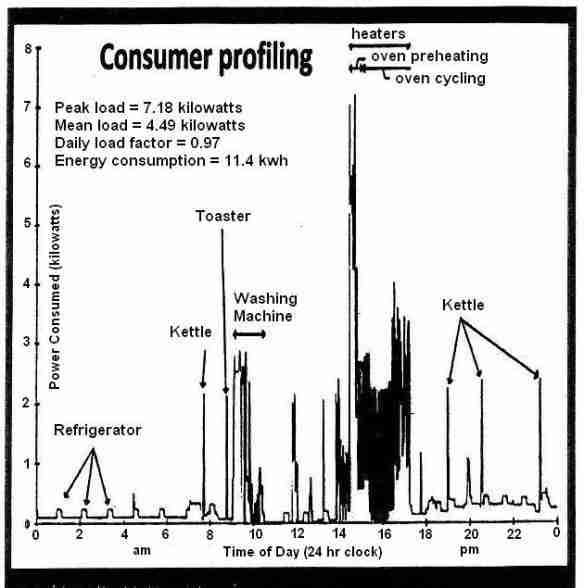The first phase of the coming assault on your privacy – is the installation of a ‘smart’ electric, gas or water meter on your home. In the case of the electric meters, it is not too much to say that they are the “gateway drug” that leads to a second even more detailed intrusion caused by the ‘smart appliances’ soon to be in stores everywhere. The appliances will be the subject of our next web page.
Smart gas and water meters violate your privacy in the same way as smart electric meters, but the electric ones are the most invasive so will be addressed first.
Once a ‘smart’ electrical meter is installed on your home, even before there are any smart appliances in the home, much information about your daily activities will be revealed to the utility company – and to anyone who can buy (or hack into) the data the meter generates.
The hypothetical graph below illustrates what might be learned from the data generated by a single smart meter on a home:
1 – Above graph excerpted from Smart Metering & Privacy: Existing Law and Competing Policies, State of Colorado Public Utilities Commission.
In fairness it should be noted that data as detailed as shown above could only be generated by a meter set to measure data in very small intervals – say one minute or two minute intervals. The presently announced plan of DTE is to measure this data in either 15 minute intervals or at hourly intervals. Bear in mind though, that this is only a starting point and that these meters are remotely reprogrammable – so that their measurement interval could be changed to record by the minute by sending a wireless signal to change the meter’s firmware. The utility would have the ability to selectively look at data from any home in as much detail as it wished just by fine tuning the measurement interval. As a homeowner you would have no way of knowing if this were being done to your home.
Looking at the above data, can you answer these questions:
- When is the household asleep?
- When do the occupants arise and have breakfast?
- Is there more than one refrigerator in the house?
- Is there more than one stove?
- Is there more than one family?
- Is there any long period when no one is home?
- Are there periods when only the woman is home?
- Is marijuana being grown in the attic?
- Will there be a home cooked meal on this day?
- Is this laundry day?
- When do occupants access the internet?
But, you say, the graph is labeled as to which appliance is which. How could these appliances be identified on the unlabeled data that a smart meter would produce? The answer is that each appliance has unique characteristics in terms of the amount of current it draws, the duration of that draw, and something called the “power factor” associated with its use. The power factor of an electric motor is different than that for lighting or electric heaters. Thus each appliance has a kind of ‘signature’.
Who would want this information?
- Marketing companies
- Insurance companies
- Employers
- Census and poll takers
- Fundraisers for charities
- Law enforcement
- Criminals
What about ‘smart’ gas and water meters?
The types of information revealed are similar. When do household members take baths or showers? Is the lawn being watered on the wrong days (where there is water rationing). How often is laundry being done? Does an unusual pattern of gas or water consumption suggest the possibility you are running a business out of your home? Would an unusual pattern provide ‘probable cause’ for a police search of your home?
All of the above is only the beginning. The next phase is detailed on our next web page.
